Workplace Safety Screenings stresses the importance of letting your workers in on the why of safety protocols. Sure, everyone can comprehend that safety is important and injuries should be avoided, but when you are implementing safety protocols, especially if the protocol adds extra steps that employees find burdensome or time-consuming, the extra explanation is worth your time. By thoroughly explaining and letting your employees contribute to the conversation about safety, you shift their mindset from an obligation to comply with management to a honorable, personal desire to help keep everyone safe.
The problem that can arise from safety protocols is they are often very simple solutions. Most accidents and injuries are easily avoidable through common sense controls and minimal effort. The rejection of safety protocols can come because they feel basic to employees who might develop a “how much can this really help?” attitude. Your safety plan should acknowledge and address the very fact that solutions are basic and won’t require too much strain to be extremely effective to avoid injuries, accidents and fatalities.
Common safety issues to address in training include:
Falls & Slips
These are among the most frequent on the job injuries. Work with employees to identify if their specific job role might include greater risks of spilled substances or obstructions to the work area. Supply employees with proper PPE like no-slip or steel-toe footwear and signage to help alert others to slick or compromised surfaces that should be avoided. Training should include assigning responsibility for spill clean-up or debris removal, the protocol for alerting that person, and an expected time frame for how quickly an issue will be resolved.
Stacking
It is all too easy to absentmindedly stack materials in order to move them away for later or to try and free up floor space, but it can also be dangerous. Your safety plan should include pathways that are never obstructed with materials that impede safe movement through the workspace. It should also include limits on height and weight capacity so that employees are not tempted to stack items that can topple down on top of people, their appendages, other equipment or that would block passage or trap an employee.
Fire Hazards
Fire Hazards will vary from industry to industry, but remains a top threat to any space. Farming, for example, includes storing combustible materials, whereas a printing press uses chemicals near large quantities of flammable items. Even a basic office situation can employ common sense practices to not only prevent a fire, but impede spreading. Every safety plan should include proper storage of flammable items, making sure those items are adequately separated from outlets, machinery, or heating elements. Employees should know where to locate and how to operate fire prevention tools like sprinklers and extinguishers. Alarms should be accessible to employees to alert others and evacuation procedures would be second nature.
You may spend a lot of time going over safety protocols as it relates to the biggest threats to your particular industry, but don’t forget to reiterate the most basic safety mishaps and preventions. When a real-life safety issue comes to life, you want your employees to act quickly with their wits in tact. When employees panic from lack of knowledge, your chance of injury or death dramatically increases. With proper and frequent refresher courses, cool heads will prevail and your people will stay safe.
Come back for part three of our When, Why & How- Safety Training series. Contact Workplace Safety Screenings for more information about comprehensive workplace safety programs.

.png?width=500&height=500&name=Blue%20and%20White%20Classic%20Shield%20Financial%20with%20Star%20Logo%20Design%20(1).png)


